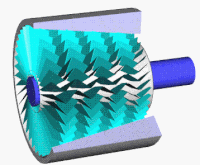
Photo from wikipedia
Here, we use numerical analysis to study the effects of a shock control bump (SCB) on the performance of a transonic axial compressor blade section and to optimize its shape… Click to show full abstract
Here, we use numerical analysis to study the effects of a shock control bump (SCB) on the performance of a transonic axial compressor blade section and to optimize its shape and location to improve the compressor performance. A section of the NASA rotor 67 blade is used for this study. Two Bézier curves, each consisting of seven control points, are used to model the suction and pressure surfaces of the blade section. The SCB is modeled with the Hicks–Henne function and, using five design parameters, is added to the suction side. The total pressure loss through a cascade of blade sections is selected as the cost function. A continuous adjoint optimization method is used along with a RANS solver to find a new blade section shape. A grid independence study is performed, and all optimization and flow solver algorithms are validated. Two single-point optimizations are performed in the design condition and in an off-design condition. It is shown that both optimized shapes have overall better performance for both on-design and off-design conditions. An analysis is given regarding how the SCB has changed the wave structure between blade sections resulting in a more favorable flow pattern.
Journal Title: Shock Waves
Year Published: 2017
Link to full text (if available)
Share on Social Media: Sign Up to like & get
recommendations!